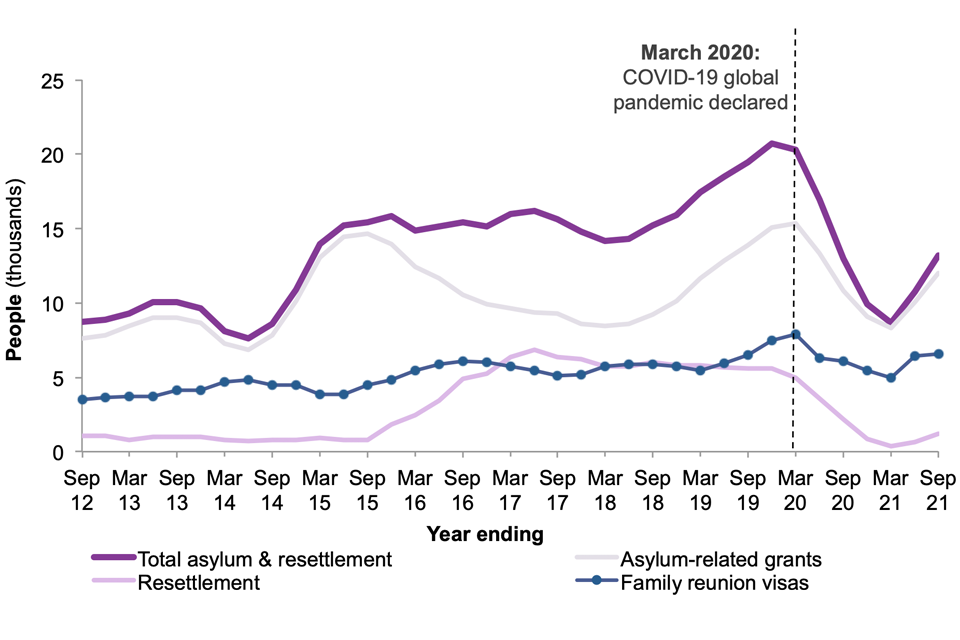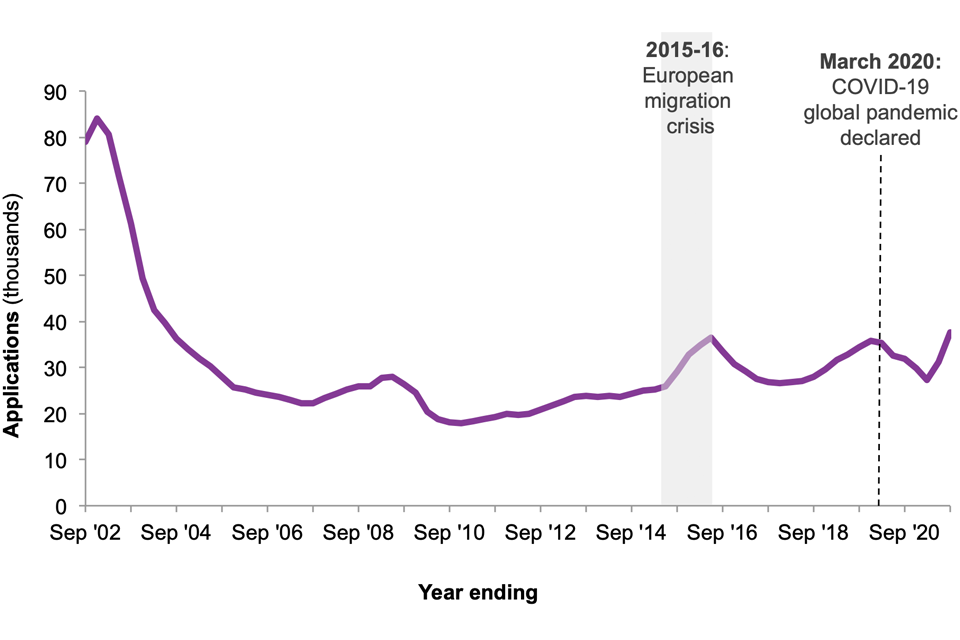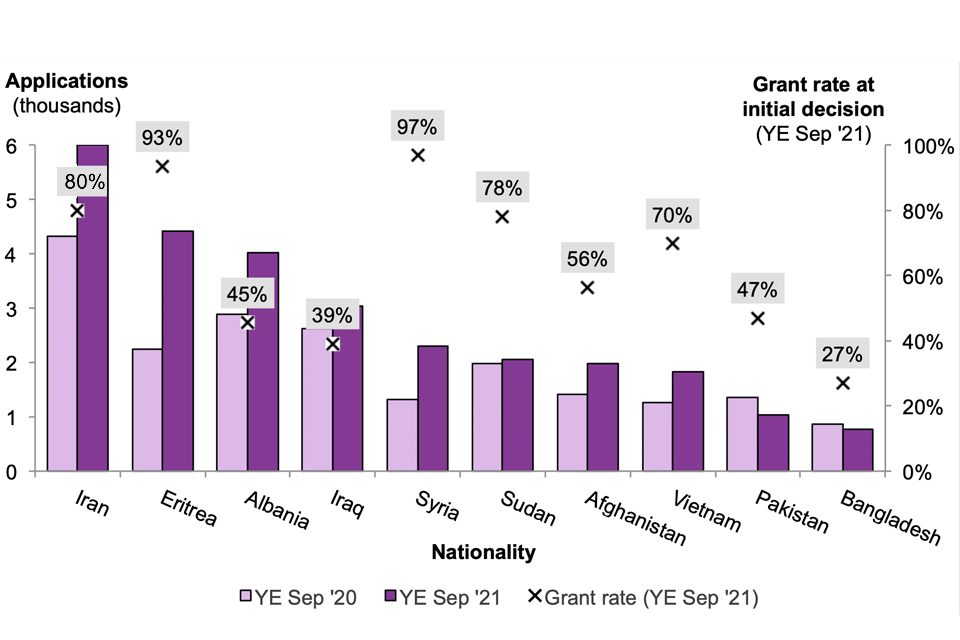How many people do we grant asylum or protection to?
Published 25 November 2021
Back to ‘Immigration statistics, year ending September 2021’ content page.
This is not the latest release. View latest release.
Data relate to the year ending September 2021 and all comparisons are with the year ending September 2020, unless indicated otherwise.
On 11 March 2020, the World Health Organisation (WHO) declared the COVID-19 outbreak as a global pandemic. A range of restrictions were implemented in many parts of the world, and the first UK lockdown measures were announced on 23 March 2020. The COVID-19 pandemic has had a significant impact on the UK immigration system, both in terms of restricting migrant movements to and from the UK and the impact on operational capacity.
Year ending comparisons that follow will include impacts resulting from the restrictions put in place during this period of the pandemic.
This section contains data on:
- Asylum applications and initial decisions, including unaccompanied asylum-seeking children (UASC)
- Resettlement
- Family reunion visas granted
- Outcomes of asylum applications
- Asylum support
- Inadmissibility
An asylum application may relate to more than one person, if the applicant has family members (or ‘dependants’) which they request to be covered by the same application. This release features data on both the number of asylum applications or initial decisions (‘main applicants only’), and the number of people related to asylum applications and initial decisions (‘main applicants and dependants’).
Statistics on the number of applications and decisions of those applying to enter or remain in the UK under the new Hong Kong British Nationals (Overseas) route are included in the ‘How many people come to the UK each year (including visitors)’ section.
1. People granted protection and other leave through asylum and resettlement routes
This section covers individuals granted leave to remain in the UK via three routes: applying for asylum, resettlement, and family reunion visas.
The UK offered protection, in the form of asylum, humanitarian protection, alternative forms of leave and resettlement, to 13,210 people (including dependants) in the year ending September 2021. Of these:
- 81% were granted refugee status following an asylum application (‘asylum’)
- 7% were granted humanitarian protection
- 3% were granted alternative forms of leave (such as discretionary leave, UASC leave)
- 9% were granted refugee status through resettlement schemes, although this proportion was lower than in recent years due to the COVID-19 pandemic
Additionally, 6,524 partners and children of refugees living in the UK were granted entry to the UK through family reunion visas, 8% more than the previous year.
Figure 1: People granted1 asylum-related protection2, resettlement3 and family reunion visas in the UK, years ending September 2012 to September 20214

Source: Asylum applications, initial decisions and resettlement – Asy_D02
Notes:
- ‘Total asylum & resettlement’ includes asylum-related grants and resettlement; it excludes grants of family reunion visas.
- In this chart, ‘Asylum-related grants’ are grants that resulted from an asylum application. These include asylum and also other grants where the individual does not meet the criteria for asylum (e.g. grants of humanitarian protection, discretionary leave, grants under family and private life rules, leave outside the rules and UASC leave).
- The asylum-related grants data refers to grants at initial decision. The final number of grants following appeal will be higher.
- Resettlement data prior to 2013 are only available annually. Data for individual quarters in this period have been estimated by taking 25% of the annual total.
- Includes main applicants and dependants.
Figure 1 shows that the number of people granted protection via asylum-related grants peaked twice; once in 2015-16 (during the ‘European migration crisis’) and again just prior to the COVID-19 pandemic, after which levels fell sharply. The number of people resettled rose after the ‘European migration crisis’ and remained relatively stable until March 2020 when levels dropped due to the pandemic. In comparison, the number of family reunion visas granted has shown a more consistent but gradual increase over the years, and a less substantial decrease following the COVID-19 pandemic.
The number of people offered protection (via asylum-related grants or resettlement) in the year ending September 2021 was 2% higher than the previous year, though it remains below pre-pandemic levels. This 2% rise is accounted for by an increase in the number of grants at initial decision while the number of refusals has decreased.
The data in this section includes only those granted asylum or alternative forms of leave at initial decision following an asylum application. However, there will be additional people who receive a grant of protection following an appeal against an initial refusal (see sections below on outcomes and appeals).
1.1 Resettlement
There were 1,171 people granted protection through resettlement schemes in the year ending September 2021. This is 46% fewer than in the previous year, as resettlement levels have not yet returned to levels seen prior to the COVID-19 pandemic.
In the year ending September 2021:
- 66% were resettled through the UK Resettlement scheme (UKRS), and the remainder resettled via the Vulnerable Persons Resettlement Scheme and Vulnerable Children Resettlement Scheme (which both closed at the end of February 2021), or through Community Sponsorship schemes
- the most common nationalities of those resettled were Syrian (77%), Iraqi (8%) and Sudanese (3%)
- since the first arrivals under the new Resettlement scheme in March 2021, 775 refugees have been resettled in the UK via the UKRS
More information about current and previous resettlement schemes can be found in the user guide.
On 18 August 2021, the Afghanistan Citizens Resettlement Scheme (ACRS) was announced, with the aim of resettling up to 20,000 people at risk. For further information, see the ACRS guidance on gov.uk. We will include data on the ACRS and other relevant policies in future releases.
2. Asylum applications
There were 37,562 asylum applications (relating to 44,190 people) in the UK in the year ending September 2021. This is 18% more than the previous year and higher than at the peak of the European Migration crisis in year ending June 2016 (36,546). As shown in Figure 2, it is the highest number of asylum applications in the UK since the year ending June 2004 (39,746), although less than half the level of the previous peak in 2002 (84,132 applications), which was partly driven by military action, conflict or political unrest in countries such as Iraq, Afghanistan, Zimbabwe and Somalia.
Figure 2: Asylum applications lodged in the UK, years ending September 2002 to September 20211

Source: Asylum applications, initial decisions and resettlement – Asy_D01
Notes:
- Main applicants only.
The increase in applications is likely linked in part, to the easing of global travel restrictions that were in place due to the COVID-19 pandemic, and to an increase in small boat arrivals to the UK (of which almost all claim asylum). Applications fell substantially in 2020 Q2, following the initial COVID-19 outbreak. However, they have since increased and are now higher than levels seen prior to the outbreak - there were 15,104 applications for asylum in Q3 2021, 60% more applications than the same period in 2019, and 74% more when compared to the same period in 2020.
2.1 Applications by nationality, age and sex
Iran was the top nationality claiming asylum in the UK in the year ending September 2021 (6,002 applications), as it has been in every year since 2016.
There were 1,974 asylum applications from Afghan nationals in the year ending September 2021, an increase of 39% over the previous year. Although applications more than doubled from 2021 Q2 to 2021 Q3 (394 to 964), there is no evidence to suggest this increase so far is due to the rise in people leaving Afghanistan as a result of the events that occurred over the summer of 2021. The increase in applications from Afghan nationals is similar to those seen in other top nationalities over the same period, and coincides with an increase in small boat arrivals over the summer months.
Figure 3 shows that the number of applications increased for eight of the top 10 nationalities applying for asylum in the UK – Iranian (up 39%), Eritrean (up 97%), Albanian (up 39%), Iraqi (up 16%), Syrian (up 74%), Sudanese (up 4%), Afghan (up 39%), and Vietnamese (up 44%). Of the top 10 nationalities, two experienced a decrease – Pakistani (down 24%), and Bangladeshi (down 11%).
Figure 3: Top 10 nationalities1 claiming asylum in the UK and grant rate2 at initial decision (%), years ending September 2020 and September 2021

Source: Asylum applications, initial decisions and resettlement – Asy_D01 and Asy_D02
Notes:
-
Top 10 nationalities in the most recent year (excluding Stateless); main applicants only.
-
The percentages in the chart are the grant rate at initial decision for each nationality in the most recent year. Grant rate is the proportion of initial decisions which resulted in a grant of protection or other leave.
Table 1: Individuals applying for asylum by age and sex in year ending September 2021.
| Age | Male | Female |
|---|---|---|
| Under 18 | 12% | 6% |
| 18-29 | 42% | 7% |
| 30-49 | 22% | 8% |
| 50-69 | 2% | 1% |
| 70+ | <1% | <1% |
Source: Asylum applications, initial decisions and resettlement – Asy_D01
Notes:
- Includes main applicants and dependants.
Table 1 shows that of the 44,190 people applying for asylum in the latest year, a large proportion (64%) were males aged 18 to 49. Children accounted for 18% of total people applying for asylum. There were 3,103 applications from unaccompanied asylum-seeking children (UASC), 3% fewer than the previous year.
2.2 International comparisons
In the year ending June 2021 (the latest available comparable statistics), the fall in UK asylum applications was smaller than falls seen more widely across Europe. The number of people (including dependants) claiming asylum in the EU+ (countries in the EU, EEA and Switzerland) decreased by 21%, and in the UK decreased by 9%.
In the year ending June 2021, Germany received the highest number of asylum applicants (113,625) in the EU+, followed by France (87,180). When compared with the EU+ for the year ending June 2021, the UK received the 4th largest number of applicants (37,235). This equates to 8% of the total asylum applicants across the EU+ and UK combined over that period, or the 17th largest intake when measured per head of population.
Figure 4: The number of asylum applicants to the top three countries1 in the EU+ and the UK, year ending June 2017 to June 2021 2,3,4

Source: Eurostat Asylum statistics, and Asylum applications, initial decisions and resettlement – Asy_D01 and Asy_D02
Notes:
-
Top 3 countries in the EU+ receiving asylum applicants in the most recent year.
-
Includes main applicants and dependants.
-
The ‘Other EU+’ category includes all other countries that are European Union member states, part of the European Economic Area, and Switzerland that aren’t included in separate categories in the chart.
-
Data for the UK is sourced from Home Office data.
Figure 4 shows EU+ asylum intake has declined in recent years, with declines in the latest 2 years due in part to the COVID-19 pandemic. The UK is a small proportion of the total UK and EU+ intake, but figures have remained fairly stable when compared with Germany or Spain, which have fluctuated more.
Please note that Eurostat data are not directly comparable with Home Office Immigration Statistics data. Eurostat figures combine main applicants and dependants, and as such that is how international comparisons have been presented in this section. For a full list of differences between Eurostat and Home Office asylum statistics, see the user guide.
3. Outcomes of asylum applications
3.1 At initial decision
In the year ending September 2021, there were 14,758 initial decisions made on asylum applications. The number of decisions was 6% fewer than the previous year, in part, as a result of the COVID-19 pandemic. Although the number of decisions made has increased in the latest two quarters, the numbers remain below levels seen before the pandemic.
Almost two thirds (64%) of the initial decisions in the year ending September 2021 were grants of asylum, humanitarian protection or alternative forms of leave. The proportion of grants is higher than the previous year (49%), and higher than levels prior to 2019, when around a third of initial decisions were grants. This is in part because the number of grants has increased, returning to levels similar to those prior to the COVID-19 pandemic, while the number of refusals has decreased, remaining below pre-pandemic levels.
The overall grant rate can vary for a number of reasons, including the protection needs of those who claim asylum in the UK, along with operational or policy decisions. Grant rates vary considerably by nationality as the protection needs of specific groups or individuals differ, usually depending on the situation in their home country. Of nationalities that commonly claim asylum in the UK, Libyans and Syrians typically have high grant rates at initial decision (98% and 97% respectively), while nationals of India, China, and Bangladesh have low grant rates (5%, 22% and 27% respectively; see Figure 3).
3.2 At appeal
Some initial decisions (mainly, but not entirely, refusals) will go on to be appealed.
There were 4,282 appeals lodged on initial decisions in the year ending September 2021. This is 30% fewer than the previous year, in part reflecting the smaller number of applications processed due to the pandemic and the smaller number of applications refused in the latest year, but this continues a downward trend for numbers of appeals lodged since 2015.
Of the appeals resolved in the year ending September 2021, almost half (48%) were allowed (meaning the applicant successfully overturned the initial decision). The proportion of appeals allowed has risen from 29% in 2010, when the timeseries began.
3.3 Applications awaiting outcomes
At the end of September 2021, there were 67,547 cases (relating to 83,733 people) awaiting an initial decision (41% higher than the previous year). The number of cases awaiting an initial decision has shown an overall increase in the last ten years, and more rapidly since 2018.
Data on the total number of cases in the asylum system (‘asylum work in progress’), including cases awaiting appeal outcomes and failed asylum seekers that are subject to removal from the UK, is published in the ‘Immigration and Protection’ data of the Migration Transparency Data collection. The latest data available (for the end of June 2021) shows a total of 125,316 cases in the ‘work in progress’.
4. Support provided to asylum seekers
People in the asylum system who are destitute are entitled to a level of support. This could be the provision of accommodation, subsistence (cash support) or both.
At the end of September 2021, there were 62,651 individuals awaiting a decision on their asylum application who were in receipt of support, 10% higher than the previous year. This continues the trend of increasing numbers in receipt of support since the start of the COVID-19 pandemic, when the Home Office temporarily ceased ending asylum support for those whose claims have been either granted or refused, to ensure people were not made homeless during lockdown. This increase is also in part related to the recent increases in asylum applications.
Of the 62,651 individuals in receipt of support:
-
92% were in receipt of support in the form of accommodation and subsistence (including 16,794 who were in receipt of temporary support under Section 98 of the Immigration and Asylum Act (1999))
-
8% were in receipt of subsistence only
In addition, there were 6,096 people in receipt of Section 4 support, which is provided to individuals whose asylum application has been refused but they are destitute and there are reasons that temporarily prevent them from leaving the UK.
5. Inadmissibility
From 1 January 2021, following the UK’s departure from the EU, strengthened inadmissibility rules came into effect. From Q1 to Q3 (January to September) 2021:
-
7,006 asylum claimants were identified for consideration on inadmissibility grounds
-
6,598 ‘notices of intent’ were issued to individuals to inform them that their case was being reviewed in order to determine whether removal action on inadmissibility grounds was appropriate and possible
-
48 individuals were served with inadmissibility decisions, meaning the UK would not admit the asylum claim for consideration in the UK system, because another country was considered to be responsible for the claim, owing to the claimant’s previous presence in or connection to a safe country
-
10 individuals were returned
-
2,126 individuals were subsequently admitted into the UK asylum process for substantive consideration of their asylum claim
The number of returns includes both enforced and voluntary returns. Enforced returns were made to Denmark, Ireland, Italy, Slovenia, Spain, and Sweden.
For further information, including breakdowns of the data by quarter and nationality, see Asy_09a and Asy_09b of the summary tables.
6. About the statistics
This section provides information on those applying for and granted protection in the UK through both asylum and resettlement routes. Further data relating to asylum and resettlement can be found in our data tables, and further details on the statistics can be found in the user guide.
The data are used to assess the trends in numbers of people seeking and being granted protection, the impact of policy changes, and to understand the demographics of those coming to the UK to claim protection. Data on resettlement and support, broken down by local authority, can help local authorities understand the demands on their services and resources to aid with planning.
6.1 Asylum, resettlement and protection
Asylum seekers are people who seek sanctuary in another country by applying for asylum – the right to be recognized as a refugee and receive protection and assistance. Asylum seekers will receive a decision on their application, which may be a grant (of asylum, or another form of protection or leave) or a refusal.
Refugees in other countries can also be given protection in the UK via resettlement schemes. The UK works with the UN Refugee Agency (the UNHCR) to arrange for the transfer of refugees from an asylum country to the UK, with the aim of ultimately granting them permanent residence. The statistics in this release do not include the resettlement of Afghan staff (and their families) who have supported British efforts in Afghanistan, since 2013. For further information, see the Home Office Afghan resettlement and immigration policy statement.
A family reunion visa allows partners and children of those previously granted asylum or humanitarian protection in the UK to reunite with them here.
The total number of individuals granted protection includes grants related to an asylum application (grants of asylum or alternative forms of leave) and resettlement. Alternative forms of leave include humanitarian protection, discretionary leave, UASC leave, leave outside the rules, and grants under family and private life rules.
Data on asylum applications relate to the period in which the application was lodged, and initial decisions relate to the period in which the decision was made. Initial decisions may, therefore, relate to an application made in an earlier period, and thus the two are not directly comparable.
Data on initial decisions will not reflect the total number of people granted protection through asylum routes as some initial decisions may be overturned following appeal. Data on the number of appeals lodged, and their outcomes, are published in Asylum appeals lodged and determined – Asy_D06 and Asy_D07.
UASC data includes those treated as an unaccompanied minor for at least one day between the date of application and the date of initial decision. Some UASC applicants may subsequently be found to be an adult following conclusion of an age dispute. Data on age disputes are published in Age Disputes – Asy_D05.
Eurostat asylum statistics can be used to compare asylum statistics with EU member states. The methodology used to compile Eurostat data differs from that used in this release; see the user guide for further details.
6.2 Support provided to asylum seekers
The data on support includes support provided under Section 95, Section 98 and Section 4. Further details on these types of support can be found in the user guide.
The data show the number of people in receipt of support on a given day, but do not show the length of time for which someone receives support or the amount of support they receive.
6.3 Inadmissibility
The inadmissibility rules provide the grounds for treating an asylum claim as inadmissible to the UK asylum system, if a person has earlier presence in, or connection to, a safe third country. It also provides for the person to be removed to that or another safe third country, with that country’s permission.
From 1 January 2021, following the UK’s departure from the EU, strengthened inadmissibility rules came into effect. Prior to the UK leaving the EU, most inadmissibility decisions were made according to the Dublin Regulation, which for the cases in its remit, established the criteria and mechanisms for determining which state was responsible for examining an application for international protection. Further details can be found in the user guide.
Data on inadmissibility are taken from internal Home Office management information and should be considered provisional. The data covers the following:
‘Identified for consideration’: Where an asylum case might be suitable for a refusal on inadmissibility grounds, case working teams will review available information to determine whether a case may be appropriate for decisions under the third country inadmissibility provisions in the Immigration Rules. If they assess that inadmissibility action might be appropriate, they will issue an individual with a ‘notice of intent’.
‘Notice of intent issued’: This is an information letter to the claimant, to inform them that their claim is being considered under inadmissibility rules. It is not a formal decision.
‘Inadmissibility decision served’ and ‘Returns’: If the case meets the inadmissibility requirements, and another country accepts the applicants return the Home Office will treat the asylum application as inadmissible under the inadmissibility rules and arrange the return.
‘Subsequently admitted into UK asylum process’: following consideration on inadmissibility grounds, where there is insufficient evidence to meet the requirements of the inadmissibility rules, or another country has not accepted responsibility for the claim within a reasonable timescale, then the asylum claim will be fully considered in the UK.
Data on transfers into and out of the UK under the Dublin Regulation (prior to the UK leaving the EU) are available in Dub_D01.
7. Data tables
Data referred to here can be found in the following tables:
Additional data relating to asylum, protection and resettlement published in earlier Immigration Statistics releases include:
Statistics on the number of applications and decisions of those applying to enter or remain in the UK under the new Hong Kong British Nationals (Overseas) route are included in the ‘How many people come to the UK each year (including visitors)?’ section.
We welcome your feedback
If you have any comments or suggestions for the development of this report, please provide feedback by emailing MigrationStatsEnquiries@homeoffice.gov.uk. Please include the words ‘PUBLICATION FEEDBACK’ in the subject of your email.
We’re always looking to improve the accessibility of our documents. If you find any problems or have any feedback relating to accessibility, please email us.
See section 7 of the ‘About this release’ section for more details.
